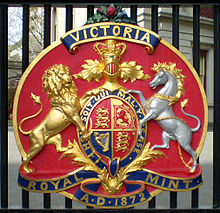| This article needs additional citations for verification. Please help improve this article by adding citations to reliable sources. Unsourced material may be challenged and removed. Find sources: "Melbourne Mint" – news · newspapers · books · scholar · JSTOR (February 2013) (Learn how and when to remove this message) |
| Melbourne Mint | |
|---|---|
 | |
| General information | |
| Architectural style | Renaissance Revival |
| Location | Melbourne, Australia |
| Opened | 1872 |
| Design and construction | |
| Architect(s) | John James Clark |


The Melbourne Mint, located on the corner of William and La Trobe Streets in Melbourne, Australia, was first established as a branch of the British Royal Mint, opening in 12 June 1872. The main building houses the administration offices, as well as the living quarters for the Deputy Master, his family and domestic servants in the right hand section. There is a pair of guard houses, one by each gate, and the assay and smelting works were in a range of buildings behind. It minted gold sovereigns from 1872 until 1931, and half-sovereigns (intermittently) from 1873 until 1915. In 1916 it commenced minting Commonwealth silver threepences, sixpences, shillings and florins. From 1923 it minted all pre-decimal denominations. It minted rarities such as the 1921/22 overdate threepence, 1923 half-penny and 1930 penny, as well as Australia's four commemorative florins in 1927 (Canberra), 1934/35 (Melbourne Centenary), 1951 (Federation Jubilee) and 1954 (Royal Visit). It assisted the Royal Australian Mint in Canberra in producing one cent coins from 1966 to 1968 and two cent coins in 1966. From 1969 all coin production moved to the Royal Australian Mint in Canberra, and the building housing the coin minting equipment was demolished shortly afterwards. The remaining administrative building became the home of the Royal Historical Society of Victoria, as well as the civil marriage registry, with many weddings in the large ground floor room. Since 1998 it has been vested in a self funded-government body that manages a number of former government buildings, and it has hosted a range of tenants.
The former Royal Mint is and is of architectural significance as one of the finest 19th century government buildings in Australia, in a restrained Renaissance revival style. It was designed by Public Works Department architect J.J Clark, best known for the equally significant Old Treasury Building, Melbourne. The facade design has been said to be based on Renaissance Palazzi, such as the paired piaster arrangement of the Palazzo Vidoni-Caffarelli, Rome (1515) attributed to Raphael, or the paired Ionic columns of the Palazzo Corner della Ca' Grande, Venice, by Sansovino (1545).
The colourful coat of arms placed on the front gates in mid-twentieth century were by the Melbourne woodcarver Walter Langcake. The original design, based on Queen Victoria's coat of arms, is adapted especially for a British Royal Mint branch office in colonial Victoria. The supporting animals are not crowned and a maned horse replaces the usual unicorn.
From 2007 the former Mint became the home for the Hellenic Museum, showcasing Greek art, history and culture.
From October 2012 private company, Melbourne Mint Pty Ltd, was situated on the ground level and level one of the Melbourne Mint building. Melbourne Mint Pty Ltd belongs to a group of Australian precious metals companies which include Australian Bullion Company (ABC), Gold Merchants International (GMI) and Melbourne Mint Coins. It has no historical relationship to the original Royal Mint.
See also
External links
- Photo: Melbourne Mint, from the State Library of Victoria
- Brief history and photographs of the Melbourne Mint, from the Australian Architecture Discussion Forum.
- Melbourne Mint - Online Coin Club, list of all coins struck by the Melbourne Mint.
References
- "THE MELBOURNE MINT". The Argus. Melbourne. 4 October 1880. p. 6. Retrieved 8 February 2012 – via National Library of Australia.
- ^ "Former Royal Mint". Victorian Heritage Database. Retrieved 15 October 2023.
- Cummings, Eddie J (2007). Renniks Australian Coin and Banknote Values. Banksmeadow: Renniks Publications. ISBN 978-09752245-5-7.
- ^ School of Historical Studies, Department of History. "Royal Mint - Entry - eMelbourne - The Encyclopedia of Melbourne Online". www.emelbourne.net.au. Retrieved 15 October 2023.
- "Former Royal Mint Site". Working Heritage. 24 November 2022. Retrieved 15 October 2023.
- "JJ Clark : architect of the Australian Renaissance / Andrew Dodd - Catalogue | National Library of Australia". catalogue.nla.gov.au. Retrieved 15 October 2023.
- "About Us". Hellenic Museum. Retrieved 15 October 2023.
37°48′44″S 144°57′24″E / 37.812153°S 144.956794°E / -37.812153; 144.956794
| Australian currency | |||||
|---|---|---|---|---|---|
| Decimal ($1=100c) |
| ||||
| Pre-decimal (₤sd) |
| ||||
| Mints |
| ||||
| Topics | |||||
| Landmarks in the Melbourne central business district | |
|---|---|
| Note: this includes landmarks in the Melbourne central business district and its immediate surrounds, not the Greater Melbourne metropolitan area | |
| Precincts | |
| Entertainment | |
| Shopping centres | |
| Public museums | |
| Institutions | |
| Notable structures | |
| Sports venues |
|
| Parks and gardens | |
| Transport | |
This article about a building or structure in Victoria (state) is a stub. You can help Misplaced Pages by expanding it. |
This coin-related article is a stub. You can help Misplaced Pages by expanding it. |